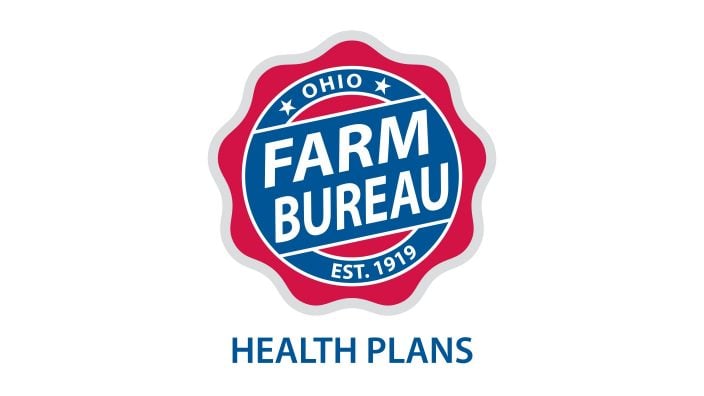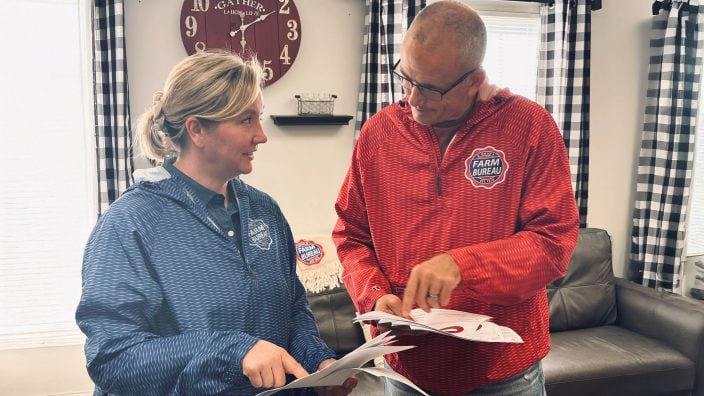Applications for Ohio Farm Bureau Health Plans now available
Members have three ways to apply: contacting a certified agent, calling 833-468-4280 or visiting ohiofarmbureauhealthplans.org.
Read MoreWith farm equipment on rural roads this fall, farmers should be sure their Slow Moving Vehicle and Speed Identification Symbol signs are properly displayed. Just as important, motorists should know what those signs mean. Farm Bureau Policy Counsel Leah Curtis talks with Joe Cornely about how these signs contribute to road safety.
Listen to Legal with Leah, a podcast featuring Ohio Farm Bureau’s Policy Counsel Leah Curtis discussing topics impacting farmers and landowners.
Joe Cornely: One of the most iconic signs driving down a back road of Ohio is coming up on the back of a piece of equipment in that bright orange multicolored actually triangle that’s on the back — the slow moving vehicle sign. There’s some other signs… SIS signs. That’s what we’re talking about today with Farm Bureau Policy Counsel Leah Curtis. Let’s just first of all start with a very basic description: The purpose of the SMV and the SIS sign.
Leah Curtis: So the SMV — the slow moving vehicle sign — is designed to alert a motorist that you are on a piece of machinery that is designed to operate at a maximum speed of 25 miles per hour. So it’s a way to let motorists know that as they’re coming up onto the back of that equipment and that they need to slow down and take caution. The SIS sign is to allow tractors that can go faster than 25 miles per hour, that they can go up to 45 miles per hour and that SIS sign is a circle with a black line around it and then it has what the maximum speed is. So the motorist behind you will be able to see that maybe you’re on a 55 mile per hour road but your tractor can only go 35 and so they know to adjust their speed accordingly.
Joe Cornely: Let’s just run over a few of the basic rules on using each one, Leah.
Leah Curtis: So an SMV sign again should be on any tractor or machinery. It has to be visible from at least 500 feet behind the tractor. And if you have a towed implement (a planter or something behind), it cannot obstruct that SMV sign. And if the SMV sign is not going to be visible from 500 feet of the towed implement, then you need to have one on the implement. It’s really a good idea to always have one on the implement too. Just make sure that people see it and it’s visible to everybody behind you. With the SIS sign it’s a little more complicated. It has to go again on any tractor that’s going to go above 25 miles per hour. It has to show what that max speed is. And when you’re on a roadway, whoever’s driving that tractor needs have a driver’s license and they need to have documentation of the speed for that tractor. So usually in your manual or your guide that came with your tractor it will say what it’s rated for. If you’re pulling other equipment, in that case it does have to have the SIS sign on the equipment as well. So again it’s a good idea to have the SMV sign on the towed implement. With the SIS sign, you have to have it on your towed implements.
Joe Cornely: So they’re for a very specific purpose which you’ve described. But it’s not a good idea to use them to mark the lane on the back road
Leah Curtis: Yes. So you can use your SMV on any animal driven vehicle, on any farm machinery. Certain construction equipment that’s on the roadway should use it. But we see a lot of people use them on driveways or other places just to show caution. But that actually is a minor misdemeanor to use it improperly. Now we’ve never seen anybody get ticketed. Nobody’s ever told us that they’ve been ticketed, but we want to make sure that we kind of retain that meaning, that we don’t dilute the usefulness of the sign by putting it in places that it shouldn’t be.
Joe Cornely: So I know you’re a lawyer not a historian but if I’m remembering right. The SMV sign 40-50 years old… The SIS sign 20 years give or take.
Leah Curtis: Yeah. Probably the SIS sign is probably even a little newer than that. I think we were one of the first states to even have it probably in the early 2000s. But you know we are seeing other states use it now and incorporate it into their law and they’re looking to us as an example as to how to use it properly.
Joe Cornely: So if you put one on the original equipment and you’ve had that equipment around for a while or the sign for a while maybe consider making sure that it’s still visible, maybe even replacing it.
Leah Curtis: Yes. Usually you get one with the tractor when you buy it but if you bought that tractor 20 years ago it’s probably time to get a new SMV sign. Once those signs fade they can lose up to 75% of their visibility. And that means you’ve lost 75% of your visibility to the motorists around you. We want everybody to stay safe and this is one of the easiest ways for people to see you, to know that you know they need to slow down, they need to take caution. So if you do see them fading, if they’re not that bright color that they were when you bought them or they look a little different than the ones you see in TSC, get a new one, wire it on, make sure it’s on there so people can see you and we can keep everybody safe.
Joe Cornely: Keep your gear well marked. It’ll make you much safer. Leah Curtis, policy counsel for Ohio Farm Bureau.


Members have three ways to apply: contacting a certified agent, calling 833-468-4280 or visiting ohiofarmbureauhealthplans.org.
Read More

One of the best decisions Shannon and Heather Utter made a few years ago was looking into a Farm Bureau member benefit that has ended up saving them thousands of dollars on their energy bills.
Read More

Ryan Hiser has experienced first-hand the importance of having the opportunity to vote on issues that will affect his family operation and other farmers.
Read More

Bill Patterson, Cy Prettyman and Adele Flynn will continue to serve as officers for Ohio Farm Bureau Federation.
Read More

Delegates discussed many topics impacting agriculture including farmland preservation, local foods, and succession planning.
Read More

Twenty-six farmers govern the state’s largest farm and food organization.
Read More

The 2025 recipients are Fred Cooke (posthumous) of Richland County, Marvin Dietsch of Williams County, Steven Knollman of Hamilton County and Michele Miller (posthumous) of Ottawa County.
Read More

Nathan and Jill Parriman grow seasonal crops, including Christmas trees, pumpkins and cut flowers, providing U-cut experiences that invite customers to engage directly with agriculture.
Read More

The 2025 Distinguished Service Award recipients are Craig Adams, Mike Townsley, and Kellogg Farms, Kurt Farms and Stateler Family Farms.
Read More

Ohio Farm Bureau Treasurer Adele Flynn participated in the meeting, representing Ohio farmers.
Read More